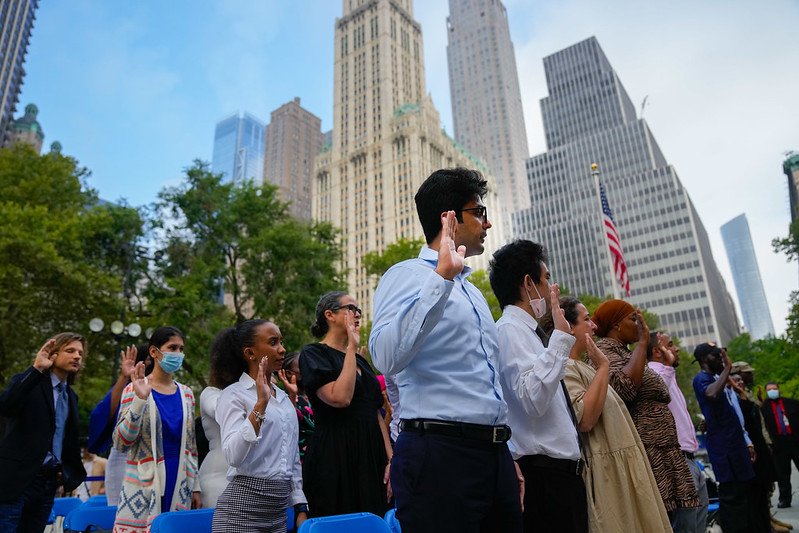
A naturalization ceremony at City Hall (photo: Michael Appleton/Mayor's Office)
The economy was the top issue on American voters’ minds this election season, with 9 out of 10 citing it as one of their biggest concerns. Especially in an era of increased partisanship, this serves as a rare moment of national agreement.
Unfortunately, that’s where the consensus stops.
The economy isn’t a simple, standalone issue, and many complex forces affect its condition. What many politicians and power brokers fail to recognize is that the economy is closely intertwined with the health and efficiency of our nation’s immigration system. That’s especially true here in New York City, where immigrants are as critical to our prosperity as Wall Street. Considering the state of our current immigration system, however, it’s no surprise our economy is struggling.
But how would a more efficient immigration system and sufficient federal resources help the economy? It’s quite easy: it’s the most efficient way to balance the labor shortage.
The economy hinges on the strength of our labor market, and the United States is facing a disastrous labor shortage. With an estimated 10 million open jobs nationwide, American businesses are struggling to find workers to fill much-needed vacancies. In New York City alone, the shortages are visible from construction sites to the halls of government. Yet we’ve seen numerous recent profiles of asylum seekers in the media and have heard from many of our own constituents from Venezuela about the sea of barriers — many the result of policy — between one’s eagerness or ability to work and securing actual employment.
One simple solution to ease the burden is to support migrant workers with easier pathways into the labor market.
The U.S. has an estimated 11.4 million undocumented immigrants in the country –– with almost 3 million coming to the country in 2022 alone. As we detailed in a recent letter we authored, cosigned by dozens of our colleagues in the New York State Senate and Assembly, to Department of Homeland Security (DHS) Secretary Alejandro Mayorkas, immigration laws prevent migrant workers from obtaining gainful employment and integrating them into a lagging workforce.
Licensing restrictions, backlogged processes, and social integration barriers are just a few hurdles recent immigrants must navigate –– all while trying to find a job. Those who can find a job are often forced to do so through an “underground economy,” where workers are often abused, exploited, and paid drastically lower than minimum wage. This is why in our letter we called for Secretary Mayorkas to, among other things within his power, extend “parole” for asylum-seekers from two months to two years and facilitate expedited work permits for asylum-seeker arrivals and those paroled into the United States.
The answer seems to be right in front of us: the U.S. has a labor shortage and there’s a steady supply of willing and able workers. Sadly, we are far from this answer becoming reality.
Partisan politicking, outdated immigration policies, and limited resources have kept migrant workers from actively leading the labor market, leaving the nation’s economy weak and uncertain. Through a more defined and regulated process, migrant workers can stabilize the economy for future generations, providing years of labor and income taxes while increasing the tax compliance rate across businesses nationwide. We cannot afford to wait. Our leaders must act to provide resources to the growing number of immigrant workers and streamline the bureaucratic process to provide pathways to employment.
This isn’t a new idea. Many nations across the globe are turning to immigration to solve their labor shortages. In Canada, immigration accounted for 84% of growth in total labor since 2010, and the Canadian Minister of Immigration recently announced the country will be increasing to 500,000 permanent resident applications a year by 2025 as a way to lessen the Canadian labor shortage. Other countries struggling with a dwindling supply of labor, such as the United Kingdom, Germany, Australia, and Japan, are exploring immigration reforms as a way to increase their workforce and ease their labor shortage. Other nations are adapting and it’s time the U.S. follows suit.
After all, our nation has always relied on New York City as its economic engine, and New Yorkers have always relied on immigrants to keep this city going. Unless we change the policies and practices that prevent them from gainful employment, however, the New York — and the United States — we have all become accustomed to will cease to exist.
We have the solution at our fingertips. It’s time to act.
***
State Senator Brad Hoylman represents the 27th Senate District and Chairs the Committee on Judiciary. Assemblymember Catalina Cruz represents the 39th Assembly District and Chairs the Task Force on New Americans. On Twitter @bradhoylman and @CatalinaCruzNY.
***
Have an op-ed idea or submission for Gotham Gazette? Email This email address is being protected from spambots. You need JavaScript enabled to view it.




